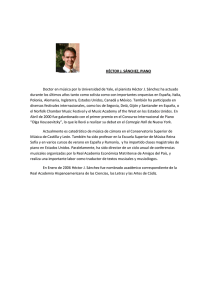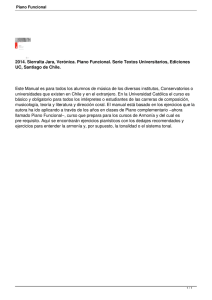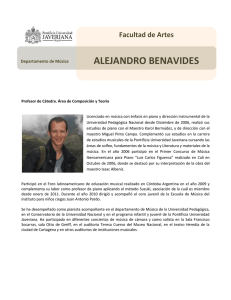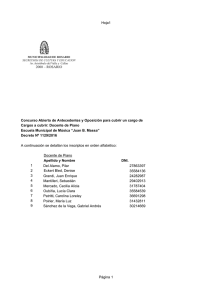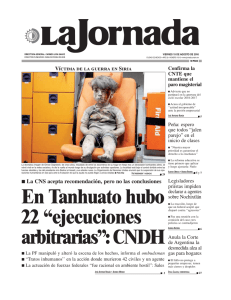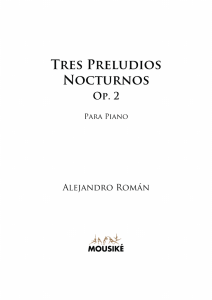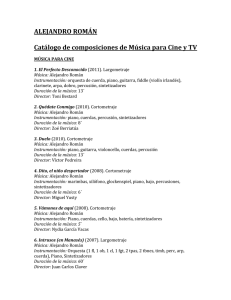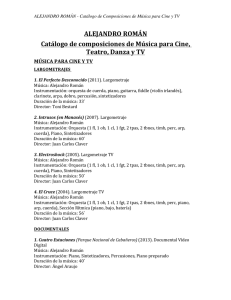Tres Gymnopedias Satiéricas
Anuncio
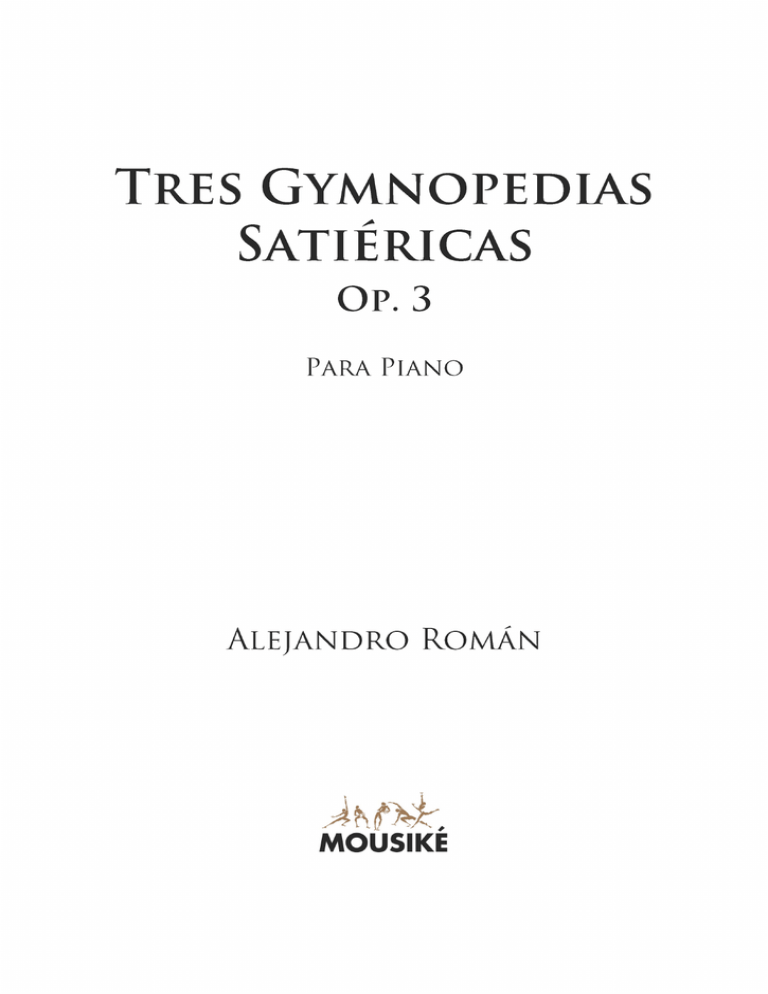
Alejandro Román
Tres Gymnopedias
Satiéricas
Op. 3
Para Piano
Primera Edición, Diciembre de 2015 © Mousiké C/ Picasso 7 28223 Pozuelo de Alarcón Madrid – (Spain) Edición y Texto © Alejandro Román, 2015 Todos los derechos reservados www.alejandroroman.com Se prohíbe la reproducción total o parcial de esta obra – incluido el diseño tipográfico y de portada -­‐ , sea cual fuere el medio, electrónico o mecánico, sin el consentimiento del autor All rights reserved in all countries on the world Alejandro Román
Alejandro Román nace en Madrid en 1971. Compositor y pianista, es considerado por la crítica como uno de los más significativos compositores de su generación. Estudió composición con Antón García Abril, Valentín Ruiz y Zulema de la Cruz en el Real Conservatorio Superior de Música de Madrid. También estudió piano de Jazz con Tony Heimer, Jorge Villaescusa y Ricard Miralles, armonía, composición y arreglos y música de cine con Claudio Gabis, Eva Gancedo y Miguel Blanco. Ha realizado cursos de especialización con Giancarlo Simonacci, Carmelo Bernaola, Adolfo Núñez, Emiliano del Cerro y Jean Claude Risset entre otros, asistiendo a diversos encuentros con compositores como Cristóbal Halffter, Leonardo Balada, Joan Guinjoan, Jesús Villa Rojo, Krzysztof Penderecki o Philip Glass. En su catálogo figuran más de sesenta de obras para piano, canto, arpa, guitarra, orquesta, cámara, electroacústica, y también es compositor de temas modernos (jazz, pop) y música para cine, teatro y danza, habiendo escrito la banda sonora de una veintena de cortometrajes y cinco largometrajes. Ha sido galardonado con diversos premios nacionales a la creación musical: Premio de la I Tribuna de Jóvenes Compositores de la Fundación Sax-­‐Ensemble por Argos, Premio “Juan Crisóstomo Arriaga” por Ménades, en el “XVI Premio SGAE Jóvenes Compositores", 2ª Premio “Ángel Iglesias” por Dos Estudios Extraños, en el “II Concurso de Composición para Guitarra “Ciudad de Badajoz”, Premio a la Mejor Banda Sonora Original por Niño Vudú en el "IX Festival de Cine Ciudad de Zaragoza". En 2015 ha recibido el “Premio Cultura Viva” en la categoría de Música por su contribución como intérprete, compositor, investigador y pedagogo. Entre sus obras más representativas destacan “Ménades, op. 28”, para orquesta de cámara, “Argos, op. 26”, para quinteto de saxofones, dos percusionistas y piano, o las obras orquestales “Abriliana, op. 21” y “Acuarelas de Irlanda, op. 42”, aunque son sobre todo destacables sus obras camerísticas, como “Homenaje a Bartok, op. 10”, “Cuarteto de Cuerda, op. 12”, o “Diégesis, op. 52”, y especialmente las compuestas para arpa: “Ludus Ludovico, op. 30”, para flauta, cuarteto de cuerda y arpa, “Sonata, op. 9”, para flauta, violoncello y arpa, “Levedad del Amor, op. 37”, para flauta, violoncello y arpa o “Khitara y Syrinx, op. 35”, para flauta y arpa. También son de reseñar sus obras para piano, especialmente “Gaiena, diez paisajes jienenses, Op. 47”, obra encargo para la 56ª edición del Concurso Internacional de Piano “Premio Jaén”. Sus obras están editadas en varios CD´s. Es Doctor en Filosofía por la UNED, con la tesis doctoral “Análisis Musivisual, una aproximación metodológica al estudio de la música cinematográfica”. Como docente ha sido profesor de la Escuela de Música Creativa de Madrid (EMC), y profesor de Fundamentos de Composición en los Conservatorios de El Escorial y Alcalá de Henares (Madrid). En la actualidad es profesor de la Universidad Alfonso X el Sabio y del Real Conservatorio Superior de Música de Madrid, donde desde 2003 desarrolla su labor docente e investigadora como Profesor de “Composición para Medios Audiovisuales” en el Aula “C.I.N.E.M.A.” (Composición e Investigación en los Medios Audiovisuales). Es autor de varios libros, entre ellos “El Lenguaje Musivisual, semiótica y estética de la música cinematográfica”. El interés creativo de Alejandro Román se basa en la búsqueda de una música personal de cierto eclecticismo a partir de cualquier técnica, estética o inspiración que mantenga una importante conexión con nuestro mundo contemporáneo. www.alejandroroman.com Alejandro Román
Alejandro Román was born in Madrid (Spain) in 1971. Composer and pianist, is considered by critics as one of the most significant composers of his generation. He studied composition with Antón Garcia Abril, Valentín Ruiz and Zulema de la Cruz at the Royal Conservatory of Music in Madrid. He also studied Jazz piano with Tony Heimer, Jorge Villaescusa and Ricard Miralles, harmony, composition and arranging, and film music with Claudio Gabis, Eva Gancedo and Miguel Blanco. He has specialized courses with Giancarlo Simonacci, Bernaola, Adolfo Nuñez, Emiliano del Cerro and Jean Claude Risset among others, attending various meetings with composers Cristóbal Halffter, Leonardo Balada, Joan Guinjoan, Jesus Villa Rojo, Krzysztof Penderecki and Philip Glass. His catalog contains more than sixty works for piano, voice, harp, guitar, orchestra, chamber, electroacoustic, and is also a composer of modern themes (jazz, pop) and music for film, theater and dance, having written the soundtrack twenty-­‐five short films. He has received several awards for music creation: Award for Young Composers Tribune Foundation Sax-­‐Ensemble, Prize "Juan Crisostomo Arriaga" in the "XVI Prize SGAE Young Composers", 2nd Award "Ángel Iglesias" in "II Guitar Composition Competition "Ciudad de Badajoz", Award for Best Original Score in "IX Film Festival Ciudad de Zaragoza". In 2015 he received the "Living Culture Award" in the category of Music for his contribution as a performer, composer, researcher and educator. Among his most representative works include "Maenads, op. 28", for chamber orchestra, "Argos, op. 26", for quintet of saxophones, two percussionists and piano, or orchestral works "Abriliana, op. 21" and "Watercolors of Ireland, op. 42", but are especially noteworthy their chamber works, such as "Homage to Bartok, op. 10", "String Quartet, op. 12", or "Diégesis, op. 52", and the works especially composed for the harp, "Ludus Ludovico, op. 30", for flute, harp and string quartet, "Sonata, Op. 9" for flute, cello and harp, "Lightness of Love, op. 37", for flute, cello and harp or "Khitara and Syrinx, op. 35" for flute and harp. They are also review his piano works, especially "Gaiena, ten jienenses landscapes, Op. 47," a work commissioned for the 56th edition of the International "Premio Jaén" Piano Competition. His works are published in several CDs. He holds a PhD of the Department of Philosophy Aesthetics of UNED, with his doctoral thesis with the title "Analysis Musivisual, a methodological approach to the study of film music". As a teacher he has been professor of Escuela de Música Creativa of Madrid (EMC), and Professor of Fundamentals of Composition at the Conservatory of El Escorial and Alcalá de Henares. Since 2003 developing teaching and research as Professor of "Composition for Film and Audiovisual Media" at the Classroom "CINEMA" (Composition and Research in Audiovisual Media) of the Royal Conservatory of Music in Madrid. He is the author of several books, including "The Language Musivisual, semiotics and aesthetics of film music". For Alejandro Román, the creative interest is based on finding a certain personal music from eclecticism, from any technical, aesthetic or inspiration, to maintain a strong connection with our contemporary world. www.alejandroroman.com
Tres Gymnopedias
“Satiéricas”
para Piano
Escritas en 1997 en un estilo claramente cercano al de Erik Satie, la primera de estas piezas evoca la música del excéntrico compositor francés de principios de siglo XX, al estilo de las "Gymnopedies". En el caso de la segunda y la tercera, mantiene la rítmica y el carácter, aunque dentro de un lenguaje mucho más personal. Se trata, por tanto, de una visión un tanto satírica ("Satie-­‐rica") de la música de Erik Satie. Alejandro Román Written in 1997 clearly in a style close to the Erik Satie, the first of these pieces evoke the music of the eccentric French composer of the early twentieth century, the style of the "Gymnopedies". For the second and third, maintaining the rhythm and character, but within a much more personal language. It is therefore a point of view somewhat satirical ("Satie-­‐rical") of the music of Erik Satie. Alejandro Román Tres Gymnopedias
Satiéricas
Para Piano
A Susana Marugán
Tres Gymnopedias Satiéricas
Op. 3
Gymnopedia nº 1
Alejandro Román
Lento y Misterioso
3
&4 Œ
Œ
˙˙˙˙
Œ
˙˙˙
˙
˙˙˙˙
Œ
˙˙˙
˙
pp
{
? 43
˙.
˙.
˙.
˙.
p
5
˙.
& Œ
{
œ
Œ
˙˙˙˙
œ
˙
˙˙˙
œ
˙.
Œ
˙
˙˙˙
Œ
˙
˙˙˙
?
˙.
˙.
˙.
˙.
9
œ
& Œ
{
œ˙
˙˙˙
œ
œ
˙
Œ
˙
˙˙˙˙
œ
Œ
˙
˙˙˙
Œ
˙
˙˙˙
?
˙.
˙.
˙.
˙.
13
& b˙Œ . ˙˙˙
b˙
{
œ
Œ
bœ
œ˙
bb˙˙
bŒ˙. ˙˙
b ˙˙
˙.
b˙
Œ bb ˙˙˙
?
˙.
˙.
b ˙.
b ˙.
17
œ
& Œ
{
œ
b
bb ˙˙˙˙
bœ
˙.
Œ
b˙b˙˙˙
Œ
bbb˙˙˙˙
Œ
?
˙.
˙.
˙.
˙.
© Alejandro Román, SGAE 1997
b˙b˙˙˙
14
- Tres Gymnopedias Satiéricas, Op. 3 f
21
bœ
& Œ
{
b˙
Œ b˙b˙˙
˙
œ
bbb˙˙˙˙
œ
˙.
Œ
œ
Œ
˙˙˙˙
œ
˙˙˙
˙
œ
?
˙.
˙.
˙.
˙.
25
œ
œ
& Œ
{
.
Œ˙
œ
˙˙˙˙
œ
œ
Œ
˙˙˙
˙
˙œ˙˙˙
˙.
Œ
˙˙˙
˙
?
˙.
˙.
˙.
˙.
29
& ˙.
Œ
˙˙˙˙
Œ
b˙. ˙˙
Œ b ˙˙
˙˙˙
b˙.
Œ
bbb˙˙˙˙
p
{
?
˙.
˙.
b ˙.
˙.
33
& bœŒ
{
œ˙
b˙˙˙
˙. b˙˙
Œ bb ˙˙
œ
Œ
b˙
b ˙˙˙
Œ
b˙b˙˙˙
?
˙.
˙.
˙.
b ˙.
37
b ˙.
& Œ
{
? ˙.
b˙
b ˙˙˙
œ
Œ
˙.
œ
b˙b˙˙˙
bœ
n ˙.
Œ
n˙˙
˙˙
Œ
˙˙˙
˙
n˙.
˙.
15
- Tres Gymnopedias Satiéricas, Op. 3 -
41
f
& Œ
{
Œ
˙˙
˙˙
˙.
Œ
œ
Œ
˙˙˙˙
˙˙˙˙
œ
˙
˙˙˙
œ
?
˙.
˙.
˙.
˙.
45
œ
œ
& Œ
{
˙.
Œ
œ
˙˙˙˙
˙
˙˙˙
˙.
Œ
œ
œ
Œ
˙œ˙˙˙
˙
˙˙˙
?
˙.
˙.
˙.
˙.
49
œ
& Œ
˙
˙˙˙˙
˙.
Œ
b˙.
Œ
˙˙˙˙
˙˙˙˙
Œœ
bb˙˙
b ˙˙˙
p
{
?
˙.
˙.
˙.
˙.
53
& b˙Œ .
{
œ
Œ
˙˙˙˙
˙
b˙˙
b ˙˙
˙.
Œ
˙˙˙˙
˙.
Œ
?
˙.
˙.
˙.
57
& ˙.
Œ
{
?
˙.
∑
˙˙˙˙
U
˙.
˙.
˙˙˙˙
16
A Eva Gancedo
Gymnopedia nº 2
Alejandro Román
Andando
3
&4 Œ
∑
Ó
‰ œj
Ó
œ 3œ œ
˙
p
? 43 Œ ##˙˙˙˙
˙.
˙.
{
Œ ##˙˙˙˙
˙.
˙.
Œ ##˙˙˙˙
˙.
˙.
Œ ##˙˙˙˙
˙.
˙.
5
œ
&
{
? Œ
˙.
˙.
œ..
œ ˙.
R
˙
##˙˙˙
Œ
˙.
˙.
˙
##˙˙˙
Œ
˙.
˙.
‰ bœj
Ó
˙.
˙
##˙˙˙
Œ
˙˙..
b ˙.
˙
b#˙˙˙
9
œ b3œ œ bœ bœ..
b˙
&
3
b
œ œ
b
œ
œ
b
œ
œ bœ
3
œ
R #˙.
mf
? ˙Œ . b#˙˙˙˙
˙.
b ˙.
Œ b#˙˙˙˙
˙˙..
b ˙.
{
Œ b#˙˙˙˙
˙˙..
b ˙.
Œ b#˙˙˙˙
˙˙..
b ˙.
13
˙.
˙.
∑
&
Ó
p
? Œ
˙.
˙.
{
˙
##˙˙˙
Œ
˙˙˙˙
#
#
˙.
˙.
Œ
˙.
˙.
˙
##˙˙˙
© Alejandro Román, SGAE 1997
Œ #˙˙˙
˙. # ˙
˙.
‰
j
œ
17
- Tres Gymnopedias Satiéricas, Op. 3 -
17
j
œ
œ
&
œ.
bœ œ œ
J
œ.
n˙.
˙.
Œ b ˙˙˙
b˙. b˙
˙.
Œ b ˙˙˙
b˙. b˙
˙.
mf
Œ
? ˙.
˙.
b ˙.
{
b ˙˙˙˙˙
Œ b˙˙
˙˙.. b ˙˙
b ˙.
œ 3œ œ œ.
21
˙.
œ #3œ #œ ˙
œ
J
˙.
&
p
? Œ ##˙˙˙˙
˙.
˙.
Œ
˙.
˙.
Œ ##˙˙˙˙
˙.
˙.
{
Œ
#˙.
˙.
˙˙˙˙˙
n˙˙˙
3
25
œ
œ
œ
œ
J
œ.
#˙.
#˙.
&
Œ
? ˙.
˙.
Œ
#˙.
˙.
˙˙˙˙˙
{
Œ
#˙.
˙.
n˙˙˙
˙˙
˙
28
&
∑
∑
Œ
? #˙.
˙.
˙˙
˙
Œ
˙˙˙˙
#
#
˙.
˙.
bœ..
œ
R
{
Ó
‰
Œ #˙˙˙
˙. # ˙
˙.
j
œ
˙
œ 3œ œ
Œ #˙˙˙
˙. # ˙
˙.
32
bœ
&
? ˙Œ . b#˙˙˙˙
˙.
b ˙.
{
˙.
Œ ##˙˙˙˙
˙.
˙.
˙.
Œ b#˙˙˙˙
˙˙..
b ˙.
Ó
Œ ##˙˙˙˙
˙.
˙.
‰
j
œ
18
- Tres Gymnopedias Satiéricas, Op. 3 -
36
œ 3œ œ bœ
˙
˙
Œ b#˙˙˙˙
˙˙..
b ˙.
Œ ˙˙
˙. ##˙˙
˙.
Œ #˙˙˙
˙. # ˙
˙.
œ #3œ #œ ˙
œ 3œ œ œ.
œ
J
Œ
˙.
˙.
Œ
#˙.
˙.
œ ˙.
&
? Œ ##˙˙˙˙
˙.
˙.
{
40
œ 3œ œ œ.
œ
J
œ œJ
J
˙.
œ
R
bœ..
œ # 3œ # œ ˙
&
mf
Œ
? ˙.
˙.
{
44
Œ
#˙.
˙.
˙˙˙˙˙
n˙˙˙
˙.
Œ
∑
&
Œ
? #˙. #n˙˙˙
˙.
Œ
#˙.
˙.
{
˙.
˙.
∑
b ˙˙˙
b˙
b ˙˙˙
b˙
Œ
b˙.
˙.
Œ
˙.
˙.
˙
##˙˙˙
52
&
∑
Œ dim. ˙˙
?
˙. ##˙˙
˙.
{
œ
n˙˙˙
Œ b ˙˙˙
b˙. b˙
˙.
˙.
&
{
bœ
‰ J
Œ
˙˙
n
#˙. # ˙
˙.
n˙˙˙
48
Œ
? .
b˙
˙.
˙˙˙˙˙
∑
˙˙˙...
˙˙ ..
˙˙˙...
˙˙ ..
pp
Œ
˙˙˙
#
#
˙
˙.
˙.
˙.
˙.
˙.
˙.
Œ
˙.
˙.
˙
##˙˙˙
19
A Ramón Paús
Gymnopedia nº 3
Alejandro Román
Lento
3
&4
∑
∑
≈ œ œ œ
Ó
∑
p
f
˙˙
˙˙
Œ
? 43 ˙.
˙.
{
˙˙
˙˙
Œ
˙.
˙.
Œ
˙.
˙.
˙˙
˙˙
˙˙
˙˙
Œ
˙.
˙.
5
. œ œ
& œ
Œ
? ˙.
˙.
{
r œ œ œ. œ œ
œ œ
œ. œ ˙
˙˙˙
˙
Œ
˙.
˙.
Œ ˙˙˙˙
˙.
˙.
œ #œ
˙˙˙
˙
r
œ œ bœ bœ
˙
Œ ˙˙˙˙
˙.
˙.
9
. bœ œ
& œ
Œ
.
? ˙
b˙.
{
œ.
˙.
œ
bœ.
œ
˙.
Œ
˙. bb ˙˙˙˙
b˙.
b ˙˙˙˙
j
nœ
Œ
˙.
b˙.
b ˙˙˙˙
Œ
˙. bb ˙˙˙˙
b˙.
13
∑
& ˙.
∑
˙.
p
Œ
? ˙.
˙.
{
˙˙˙
˙
Œ
˙.
˙.
˙˙˙˙
Œ
˙.
˙.
© Alejandro Román, SGAE 1997
˙˙˙
˙
Œ
˙.
˙.
˙˙˙˙
20
- Tres Gymnopedias Satiéricas, Op. 3 -
17
œ. œ œ
& œ. bœ bœ œ. bœ œ œ. #œ #˙
Πcresc.
Œ
. b ˙˙˙
˙
. #˙˙˙˙
˙
?
˙
b˙.
#˙.
œ. œ #œ #˙.
f
Œ
˙.
˙.
{
˙˙
#˙˙
Œ n ˙
b˙. bb˙˙
b ˙.
21
˙.
˙.
∑
&
Œ
? b˙.
b ˙.
{
Œ
b˙.
b ˙.
b˙˙˙
∑
Œ
b˙.
b ˙.
nb ˙˙
b˙
bb ˙˙˙
Œ
˙.
# ˙.
#n##˙˙˙˙
25
˙.
∑
&
∑
∑
mf
Œ
? ˙.
# ˙.
{
#b˙˙˙
Œ
˙.
b ˙.
Œ
˙.
b ˙.
#˙˙˙
Œ
˙.
˙.
#˙˙
˙˙˙
˙
29
& Ó
≈ œ œ œ œ. œ œ œ. œ ˙
Œ
˙.
˙.
˙
? Œ˙. ˙˙˙
˙.
{
˙˙˙
˙
r œ œ œ. œ œ œ œ œ œ
œœ
Œ
˙.
˙.
Œ ˙˙˙˙
˙.
˙.
œ œ œ
œ
œ
œ œ œ
œ œ œ
œ ˙.
&
˙˙˙
˙
33
? Œ˙.
˙.
{
˙˙˙
˙
Œ
˙.
b ˙.
œ
bb˙˙˙˙
Œ
˙.
b ˙.
œ bœ œ œ b˙.
J J
b ˙˙˙˙
Œ
˙.
b ˙.
bb˙˙˙˙
21
- Tres Gymnopedias Satiéricas, Op. 3 -
37
& ˙.
∑
‰ œ œ œ œ œ œ œ œ œ œ
∑
p
pp
Œ
˙.
˙.
Œ b˙
? ˙. b ˙˙˙
b ˙.
{
Œ
˙.
˙.
˙˙˙
˙
Œ
˙.
˙.
˙˙˙˙
˙˙˙
˙
“”
œ
œ
œ
41
œ œ œœœœ
œ œœœœ
œ
œ
œ
œ
œœ
œœœœ œœœœ
œ
œ
& œœœœœ œ
Œ
? ˙.
˙.
{
44
<“> b œ œ
œ œ
&
Œ
? ˙.
b ˙.
{
Œ
˙.
˙.
˙˙˙˙
Œ
˙.
˙.
˙˙˙
˙
˙˙˙˙
œ œ œ œ œ b œ œ œ œ œ œ bœ
œœ œ˙
b
œ
œ
œ
œ œ œ bœ œ bœ
Œ
˙.
b ˙.
bb˙˙˙˙
Œ
˙.
b ˙.
b ˙˙˙˙
bb˙˙˙˙
˙.
Œ b b˙˙
˙. b ˙˙
b ˙.
48
œ. œ #œ #œ #œ #œ. ˙
œ. œ œ
& œ. bœ bœ œ. bœ œ œ. #œ #˙
cresc.
Œ
Œ˙.
˙
b ˙˙˙
˙. #˙˙˙˙
?
b˙.
#˙.
Œ
˙.
˙.
{
f
˙˙˙
#˙
Œ
b˙.
b ˙.
nbb˙˙˙
52
˙.
˙.
˙
œ œ œ œ
R
&
œ. œ ˙
p
Œ
? b˙. b˙˙˙
b ˙.
{
Œ n #˙˙
˙. # # ˙˙
# ˙.
Œ
˙.
# ˙.
#b˙˙˙
Œ
˙.
˙.
˙˙˙
˙
22
- Tres Gymnopedias Satiéricas, Op. 3 -
56
˙
œ œ œ œ œ. œ
R
& ˙
Œ
? ˙.
˙.
{
˙˙
˙˙
Œ
˙.
˙.
˙
˙˙
˙˙
œ
R œ œ œ œ. œ ˙
Œ
˙.
˙.
˙˙
˙˙
Œ
˙.
˙.
˙˙
˙˙
60
& ˙
œ œ œ œ œ œ œ œ ˙
R
Œ
˙.
˙.
˙
? Œ˙. ˙˙˙
˙.
{
˙˙˙
˙
.
œ œ œ œ ˙
˙
Œ . ˙˙˙
˙ ˙
˙.
Œ ˙˙˙˙
˙.
˙.
64
˙
˙.
˙.
˙.
Œ
˙.
˙.
˙˙˙ Œ
˙ ˙.
˙.
˙˙˙ Œ
˙ ˙.
˙.
œ 3œ œ
&
? Œ˙.
˙.
{
˙˙˙
˙
U
˙.
68
˙.
&
ppp
Œ
? ˙.
˙.
{
˙
˙˙˙
U
˙.
U
˙ . ˙˙˙...
˙.
˙˙˙
˙
ALEJANDRO ROMÁN Catálogo de Obras para Piano “Miniaturas, op. 1” (1997) Duración: 11 min. “Tres Preludios Nocturnos, op. 2” (1997-­‐2004) Duración: 12 min. “Tres Gymnopedias Satiéricas, op. 3” (1997) Duración: 6 min. “Orestes, op. 4” (1997) Piano Preparado Duración: 4 min “Sonatina, op. 7” (1999) Duración: 11 min. “Entre Arrecifes, op. 11” (1999) Duración: 4 min. “Black Cage, op. 19” (2002) Piano preparado y electroacústica Duración: 8,5 min “Gaiena, doce paisajes jienenses, op. 47” (2013) Duración: 7 min. “Ewig, op. 58” (2015) Duración: 7 min. “Abriliana, op. 21b” (2015) Duración: 6´5 min. “Catálogo de Elfos y Hadas, op. 36b” (2015) Duración: 12 min. “OidaRadio 2, op. 59” (2015) Duración: 4´5 min. “Bocetos Flamencos, op. 12b” (2016) Duración: 21 min.
